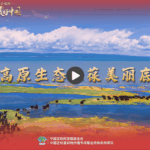Today, the Humble Administrator’s Garden in Suzhou announced the completion of a special project to replace bamboo fences. Across the garden, 80% of the bamboo fences that once lined walkways and flower beds have been replaced with nearly invisible black rubber cords, while the remaining 20% remain as part of the landscape.
A photographer captured an image of the Lotus Pavilion without bamboo fences and remarked, “This is the true elegance of a Suzhou garden!”
As a masterpiece of “creating a universe within a tiny space,” the Humble Administrator’s Garden was inscribed on the UNESCO World Heritage List in 1997. Since the 1990s, visitor numbers have steadily increased, with recent data showing nearly 20,000 daily visitors. Bamboo fences were originally installed to protect the scenery.
However, the excessive use of bamboo fences diminished the garden’s aesthetic appeal. “We wanted to restore the garden’s authenticity and fully showcase its beauty,” said the garden’s management director.
“The success of reducing trash bins gave me confidence to remove the bamboo fences,” the director explained. In 2019, the garden cut down over 140 pairs of trash bins while increasing cleaning frequency to every 15 minutes. This reduced waste disposal by 90%, with more visitors carrying their own trash bags.
This shift from “rigid control” to “flexible guidance” inspired the search for an alternative to bamboo fences—one that protected the landscape without its drawbacks.
Starting in late 2023, the garden tested materials like fishing nets before settling on black rubber cords for their near-invisibility, safety, and low cost.
“Some visitors used to sit on or step over bamboo fences, damaging plants and sometimes even their clothes,” said a gardener. “The rubber cords are placed higher and gently rebound when touched, effectively protecting plants while reducing annual maintenance costs from 300,000 yuan to under 10,000 yuan.”
During a random survey of 13 visitors, only two noticed the rubber cords. A tourist from Inner Mongolia said, “The cords are very safe and serve as a good reminder.”
An expert from Nanjing University noted that the seemingly simple rubber cords reflect Suzhou’s cultural heritage, “returning the scenery to the people while restoring trust.” The shift from bamboo fences to rubber cords also fosters social trust and raises awareness of cultural preservation and civic responsibility.
In recent years, China has made significant progress in cultural heritage protection. “The rubber cord solution aligns with principles of minimal intervention and sustainable use, meeting public demand for cultural enrichment while setting an example for heritage conservation and social progress,” the expert added.
A Small Cord, A Big Step in Awareness
On March 1, the newly revised Law on the Protection of Cultural Relics came into effect, emphasizing “enhancing historical consciousness, strengthening cultural confidence, and advancing socialist spiritual and material civilization.”
The Humble Administrator’s Garden’s switch from bamboo fences to rubber cords, though subtle, carries deep symbolism. It represents not just technical innovation but also a commitment to preserving heritage with minimal intervention.
The change also reflects a return to the garden’s original philosophy—harmony between humanity and nature, where man-made elements blend seamlessly with the natural world. Bamboo fences, while functional, disrupted this harmony and compromised the garden’s authenticity.
In a way, the rubber cords represent a trust-based contract. When visitors feel trusted, they are more likely to follow rules. The cords’ flexibility also accommodates natural human behavior rather than imposing strict prohibitions.
From reducing trash bins to introducing rubber cords, the garden’s approach replaces enforcement with trust, encouraging self-discipline and empathy for cultural heritage. As experts noted, this method rebuilds the relationship between civilization and rules while ensuring the living protection of heritage.



